
CHATRANJ COMPOSITION
Problémistes Marocains
Par
Mohamed Jamal Elbaz
Federation Royale Marocaine des Echecs - FRME

|
|
CHATRANJ COMPOSITION Problémistes Marocains Par
Mohamed Jamal Elbaz Federation Royale Marocaine des Echecs - FRME
|
|

Jugement Help Mat H#2 2éme Concours FRME
Juge : Valery Gurov0
Participant au 2éme FRME H2# :
Mihaiu CIOFLÂNCA (F1,F2),János Csák (F4,F5),Anton Bidlen (F6),Youness Ben Jelloun (F7,F15),Jamal Elbaz (F3,F10,F13,F28), Zivko Janevski (F8,F9), Miroslav SVÍTEK (F11,F12),Emanuel Navon (F14),Francesco SIMONI (F16),Vitaly Medintsev (F17,F18), ZOLTAN LABAI (F19,F20),Valerio AGOSTINI (F21),Bakani Mustapha (F22,F23),Viktor Syzonenko (F25),Vladislav NEFYODOV (F26), Jorge LOIS&Jorge KAPROS (F27),Michel CAILLAUD (F29),Jakub MARCINISZYN (F30),Emil Klemanic (Slovakia) et Michal Dragoun (Czechia) (F31), Alexander Pankratov (F32),Ivunin Alex & Pankratiev A (F33,F34),Menachem Witztum (F35),Vidadi Zamanov (F36,F37), Ladislav Packa (F38,F39),Mihajlo Milanovic (F40,F41),Onkoud Abdelaziz (F42,F43).
First, I want to thank the Moroccan federation for the invitation to judge this tournament.
Also I express huge gratitude to Georgy Evseev for the translation into English.
I had received 43 anonymous compositions.
F1, F10 – unneeded white pieces in one of solutions.
F2, F9 – repeated black moves not justified by problem’s contents.
F15 – similar idea was achieved with different self-blocks.
F22 – many repeated moves not justified by problem’s contents.
F23 – same mate in two solutions.
F8 – the problem lacks any unifying idea.
F40 – contain exactly the half of contents of http://www.yacpdb.org/#381773
F12 - reworking of http://www.yacpdb.org/#400167
F33 – formally original, but comparison with http://www.yacpdb.org/#394227 does not seem beneficial for this problem

Vladislav NEFYODOV (F26). 1 Prize
a)1.Cc4+ Re4+ 2.Rxh4 Rd3‡ 1.Cf7+ Rf5+ 2.Rxh3 Rg6‡
b)1.Ce4 Txe4 2.Td4 Rxd4‡ 1.Cdf5 Fxf5 2.Fe6 Rxe6‡
Two very harmonious pairs of solutions decorated with a perfect analogy of play, crosschecks, sacrifices of pieces and a battery play of white. All complex is combined as a whole by a play of the same thematic white and black pieces. Obviously, a lucky find for the author!
Jakub MARCINISZYN (F30). 2 Prize.
A) 1.Rc6 Ke7 2.Kc5 Ba7# 1.Rd3 (Ke3?) Rc4+ A 2.Ke3 Bf4# c
B) 1.Qd2 Bc7 2.Kc3 d Be5# B 1.Rd6 Sxe2+ 2.Ke5 Re8#
C) 1.Qe4 (Kd3?) Be5+ B 2.Kd3 Rc3# d 1.Ke4
Rc7 2.Kf4 c Rc4# A
Problem with good tactical contents: self-pinning, antidual, white Grimshaw, battery play. Three pairs of solutions are well combined by the shift of white knight. But there are also shortcomings: the third pair of solutions isn't fully harmonious, and it would have been preferable to see a position without the white pawn playing only once.
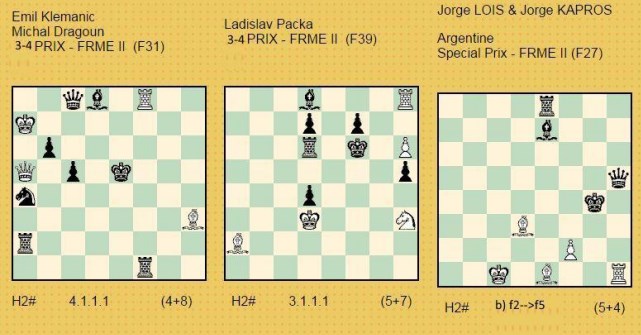
Emil Klemanič (Slovakia) & Michal Dragoun (Czechia) (F31). 3-4 Prize
I. 1.Qf5 Qe1+ 2.Ke4 Rxf5#
II. 1.Rf5 Qxc5+ 2.Ke6 Bxf5#
III. 1.Qd8 Qxb6 2.Qd4 Qe6#
IV. 1.Rd1 Qb4 2.Rd5 Qf4#
Again HOTF in an refined position – meredith. Very harmonious and elegant play of white and black linear pieces, selfpinnings, self-blocks. Pleasant problem.
Ladislav Packa (F39). 3-4 Prize
1.Kf6-g6 Ba2-d5 2.Bd8-f6 Bd5-e4 #
1.Kf6-f5 Rh8-g8 2.Rd6-f6 Rg8-g5 #
1.Kf6-e7 Sh3-f4 2.f7-f6 Sf4-g6 #
Cyclic interference of black pieces on the square vacated by black king. At the same time uniform play of white: different mating pieces move twice. Of course, interference is not pure, but with self-block, but problem’s form is lightweight – meredith and all the idea leaves good impression.
Jorge LOIS & Jorge KAPROS (F27). Special Prize
a) Diagram
1. Dh2 f3 2. Kh3 Lf1#
1. Dh3 Le2 2. Kh4 f4#
b) f2->f5 A
1. Dh4 Ld2 2. Kh5 Le2#
1. Kg5 f6 2. Kh6 Ld2#
Black play and pinmates remind the well-known miniature by A. Lobusov http://www.yacpdb.org/#325407. But the author found an interesting play of white batteries that allows to give this problem a special award.
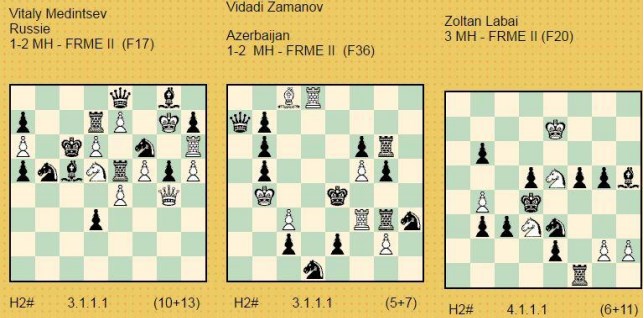
Vitaly Medintsev (F17). 1-2 Honorable mention
1.Sxh5+ Qxh5 2.Rxd6 Qxe8#
1.Sxe4 Qxe4 2.Bxd6 Qc4#
1.Sxd6 Qd1 2.Sg4 Qa4#
Triple self-pinning of black pieces with a large-scale play of a white queen. The black knight also plays on available squares three times. While in one solution it was necessary to avoid capture of white, I think that the author has ingeniously dealt with this issue changing the order of black moves.
Vidadi Zamanov F36. 1-2 Honorable mention
1. Qa2 Bxb7(A) 2. Qd5 Re8#(B)
1. Qb8 Re8 (B) 2. Qe5 Bxb7#(A)
1. Sf4 Rd7 2. Kxf5 Re7#
1. Se3 Bd7 2. Kd3 Bc6#
Two pairs of solutions are unified by a pin of black pieces on 4 different lines. It is a pity that the author didn't manage to make same black knight self-pin in the second pair.
Zoltan Labai (F20). 3 Honorable mention
1.b5 Sc6+ (A) 2.Kc4 Sde5# Umnov
1.Ke4 Sf2+ (B) 2.Kf4 Sed3# Umnov
1.Bf3 Sb2 2.Be4 Sc6# (A)
1.Rf4 Sf3+ 2.Ke4 Sf2# (B)
Harmonious play of white knights in two pairs of solutions with change of functions. But tactics is significantly simpler, than in the problems awarded with prizes.
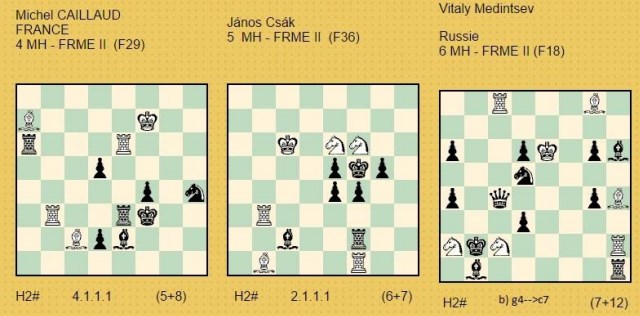
Michel CAILLAUD F29. 4 Honorable mention
1.R×b3 Rb6 2.Ké3 R×b3‡
1.Bf1 B×é3 2.Ké2 Bb6‡
1.Ra×é6 Rd3 2.Ké4 R×é3‡
1.Rd3 B×d3 2.Sg2 B×é2‡
Play of four white batteries in rather non-standard form. But for a prize there isn't enough harmony and there are rough captures.
János Csák F4. 5 Honorable mention
1.B*b1 S*f4 2.K*f4 R*f2 #
1.R*f1 S*e4 2.K*e4 B*c2 #
Elegant play with capture of two white pieces in each solution. A good form where all pieces participate in play. Of course, similar ideas are known, but I haven't found full anticipation.
Vitaly Medintsev F18. 6 Honorable mention
a) 1.Qxc8+! Kxd6 2.Sc7 Bf6# ,
b) 1.Qxh4! Kd7 2.Sf4 Rxb8#
Long-range critical moves of black queen. Line opening, Zilahi. It is a pity that the author didn't manage to make two solutions which are asked for. In fact, twins only ensure that white king plays on different squares.

Viktor Syzonenko (F25). Special Honorable mention
1.Qxe6! Bxe6 2.dxc4 Bxc4#
1.Qxf5! Sh3 2.Qxf4 Sxf4#
1.Qxg5! Rxg6 2.Qxg3 Rxg3#
Cyclic Zilahi with classic material. Change of functions of white pieces: sacrifice, guarding square e4, mate. Author had repeated the idea of P0538180, but with all first moves by black queen
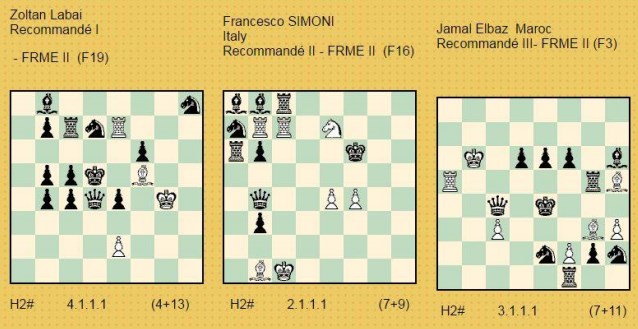
Zoltan Labai F19. Recommandé I
1.Qe5 e3 2.Qd6 Bxe4#
1.Kd6 Kf4 2.Rc6 Rxd7#
1.c3 Rxe4 2.Kc3 Be6#
1.Kc6 2.Bxe4+ 2.Qd5 Re6#
Two pairs of solutions unified by white play on same square. Unfortunately, it is impossible to name pairs identical, or play harmonious.
Francesco SIMONI F16. Recommandé II
1.D×e7 T×b6+ (Tc6+?) 2.De6 e5‡
1.D×e4 Tc6+ (T×b6+?) 2.De6 Cd5‡
Lines openings, anti-dual choice of white moves, mates by indirect battery. Unfortunately, the black queen is pinned on the same square what reduces general impression.
Mohamed Jamal Elbaz F3. Recommandé III
1.Qd5 (Rd5?) B*e2 2.Kf5 Bd3 #
1.Rc5 (Qc5?) Be8 2.Kd5 Bc6 #
1.Sg4 (Rg4?) Re5 + 2.Kf3 Re3 #
Three self-pinnings of different black pieces with anti-duals. But remaining play is too simple and overall contents is not very difficult.
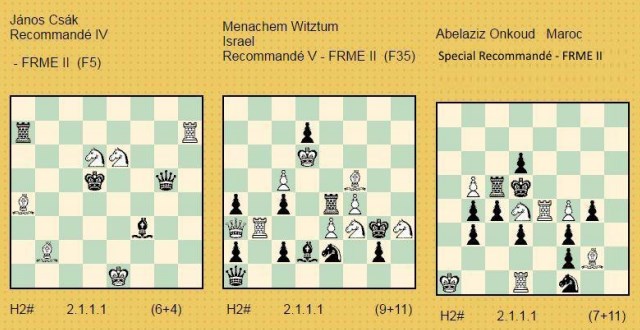
János Csák F5. Recommandé IV
1.K*e6 Sb7(S-- ?) 2.Bd5 Bd7 #
1.K*d6 Sc7(S-- ?) 2.Qc5 Rd7 #
Pleasant aristocrat problem. Anti-duals, mates from same square, change of functions of white knights.
Menachem Witztum F35. Recommandé V
1.B*e3 Qb4 2.Bc1 Qe1 #
1.R*e3 Rb8 2.Re5 Rg8 #
Line openings and interferences by black pieces. White play is determined exactly by choice of black piece opening the line.
Abelaziz Onkoud F43 Special Commendation.
1.c3 Se2 2.f*e2 R*d3 #
1.g3 Re2 2.d*e2 B*f3 #
The idea of opening of lines with sacrifices of white pieces is not new – see: http://www.yacpdb.org/#334708. The author used a smaller number of pieces and made black play more uniform.
IJ Valery Gurov, 12.12.2016
